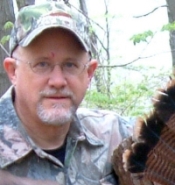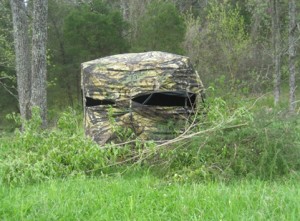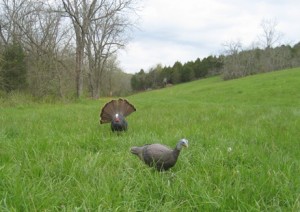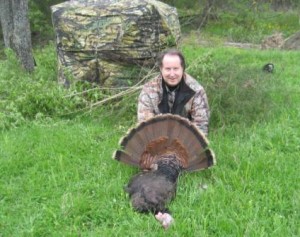Are You Making These 7 Turkey Hunting Mistakes?
(Part 3 of 3)
by Steve Sorensen
In this third and final installment of “Are You Making These 7 Turkey Hunting Mistakes?” we’ll go beyond scouting mistakes and shooting blunders, to those frustrating on-the-hunt goof-ups. They include bad set-ups, calling mistakes, and the bug-a-boo that raises its head at just the wrong time, a lack of patience.
1. Set Up Mistakes:

These turkeys came to within 10 feet of us in an open field – proof that you don’t need much cover if you remain still.
Many years ago, as a novice turkey hunter, I had permission to hunt a Polled Hereford ranch in North Carolina. The landowner showed me around and said, “Here’s a spot where I used to see turkey tracks, but I haven’t seen any for a long time. I doubt they’re here any more.”
Though the odds seemed against me, few days later a buddy and I went there and I slammed the door as I got out of his truck. A gobbler shock gobbled nearby, right along the bank of the Roanoke River. My buddy didn’t hear it, so I whispered, “Listen,” and I spit out some yelps on a diaphragm call. The gobbler sprinted toward us like Usain Bolt. I didn’t know a gobbler could arrive that fast.
The mistake I made was in failing to listen for a second gobble before making a sound. I could have pinpointed that gobbler and chosen a perfect set up. I’m a dummy.
I made another Tar Heel State gaffe a day or two later. I had a hot gobbler answering every call. He came to within 10 yards. The problem was that I was so well hidden that I couldn’t see even five yards. Repeat: I’m a dummy.
You don’t need much cover to hide from turkeys. Once, a hunting partner called two birds to about 10 feet in the middle of an open field. We were lying in a plow furrow, screened by a few whisps of long grass.
A common mistake, even among experienced hunters, is to set up with too much open ground between the hunter and the gobbler. The gobbler is looking for a hen. That’s why decoys work so well in open fields. If you don’t have a decoy, set up where he can’t see everything. Take advantage of a rock, a fallen tree, or some kind of vegetation. You’re telling the gobbler there’s a reason he can’t see the hen.
When calling gobblers uphill, a common mistake is to set up too close to the slope. Again, you want a gobbler to think there’s a reason he can’t see the hen. Set up on top, 30 yards from the drop-off, so the gobbler doesn’t expect to see a hen until he reaches the top of the hill. By then he’s in range.
2. Calling Mistakes:
Here’s where hunters lack confidence, but the truth is that hunters make fewer calling mistakes than they think they do. Yes, turkeys have incredible hearing, but they can’t distinguish a real hen yelp from a reasonable fake. Don’t be afraid of calling mistakes. If you think you’ve made a bad note, continue with a couple of good ones.

Knowing when to fold ’em one day, made this gobbler
vulnerable another day.
Forty years ago we thought we should make three perfect yelps – then shut up and get the gun ready. That can work, but it won’t work when gobblers lose interest.
My advice is to take the gobbler’s temperature. If he’s hot, you only need to encourage him. If he seems slow to respond, call softly. Make soft purrs and clucks. Convince him you’re a hen, but not an aggressive hen. If he goes silent, wait an hour – he might be coming in.
Then, turn up the volume. Get him excited. Give a command performance. After all, you’re trying to reverse the natural order of hens coming to gobblers. Be the boss hen. Order him around. Switch calls. Sound like a flock. You have nothing to lose.
3. Patience Mistakes:
Finally, we come to the tool that takes more gobblers than any other – patience. But while patience can bring success, it can also spell failure. Sometimes patience simply makes you bored and tired.
In the words of Kenny Rogers, “You gotta know when to hold ’em, and know when to fold ’em.” One day last year I was calling the classic “hung up” gobbler. He was stuck at about 100 yards, and when I called aggressively, he barely inched closer. He probably had a place where he insisted hens meet him.
That day, patience took the form of waiting till another day. A day or two later I found him roosting in a different place. I invited him home, and he accepted. In that case, patience meant folding my hand, and getting dealt a new hand another day.
There you have it – seven mistakes you can avoid. Back at the beginning I promised more beards and spurs if you fix your mistakes. But I also said there’s one thing you won’t collect more of – turkey hunting stories. It doesn’t always take a dead gobbler to make a lively story. Sometimes, stories about our mistakes are as good as stories about our successes. Without mistakes, turkey hunting couldn’t be so much fun.
***
About Steve Sorensen
 Award-winning outdoor writer and speaker Steve Sorensen loves the Havalon knife, and has been a fan of knives since he begged his dad for a hunting knife when he was six years old. His articles have been published in Deer & Deer Hunting Magazine, Sports Afield, and many other top magazines across the USA. Invite Steve to speak at your next sportsman’s event, and follow his writing on his website, www.EverydayHunter.com.
Award-winning outdoor writer and speaker Steve Sorensen loves the Havalon knife, and has been a fan of knives since he begged his dad for a hunting knife when he was six years old. His articles have been published in Deer & Deer Hunting Magazine, Sports Afield, and many other top magazines across the USA. Invite Steve to speak at your next sportsman’s event, and follow his writing on his website, www.EverydayHunter.com.
Click HERE to read more articles by Steve.
2,405 total views, 5 views today












